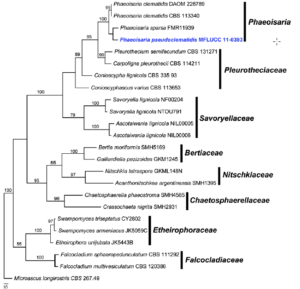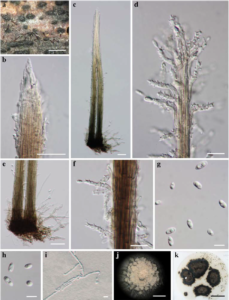Phaeoisaria pseudoclematidis D.Q. Dai & K.D. Hyde.
Index Fungorum number: IF550942, Facesoffungi number: FoF00452, Figs. 1 and 2
Etymology: In reference to its similarity with Phaeoisaria clematidis.
Holotype: MFLU 14–0824
Saprobic on bamboo culms, formed mostly at the nodal region on host surface. Mycelium immersed on the substrate, composed of septate, branched, brown hyphae. Sexual morph Undetermined. Asexual morph Conidiophores 50– 500×2–3μm, macronematous, synnematous, brown to dark brown, septate, branched, smooth, single conidiophores. Synnemata erect, rigid, dark brown, velvety, smooth, composed of compactly and parallels adpressed conidiophores, 200–500μm long, 40–80μm wide at the base, 40–60μm wide in the middle, 20–30μm wide at the apex, with flared conidiogenous cells in the above half. Conidiogenous cells 5–20×2–3μm (x=13.1×2.6μm, n=50), terminal, integrated or discrete, short, recurved, ellipsoidal, brown to dark brown, smooth, denticulate, polyblastic, sympodial, each with one to several denticulate conidiogenous loci. Conidia 5–8.5×3– 4μm (x=6.7×3.3μm, n=50), cylindric-ovate, straight, aseptate, hyaline, smooth-walled, guttulate.
Culture characters: Conidia germinating on PDA within 24 h and germ tubes produced from lower end. Colonies growing slowly on PDA, reaching 3 mm in 2 week at 28 °C, flat, circular, dark brown from forward and the reverse. Mycelium immersed in media, composed of branched, septate,
smooth, dark brown hyphae.
Material examined: THAILAND, Chiang Rai, Mae Sae Village, on dead culm of bamboo (Bambusae), 14 May 2011, Dong-Qin Dai DDQ 0020 (MFLU 14–0824, holotype), (isotype deposit in KUN, under the code of HKAS 83939), living culture, MFLUCC 11–0393=ICMP. GenBank ITS: KP744457; LSU: KP744501; SSU: KP753962.
Notes: Phaeoisaria was introduced by Höhnel (1909) for a collection on Gigantochloa sp. (Bambusae) and is typified by P. bambusae Höhn. This genus is characterized by black synnemata with polyblastic, sympodial, denticulate, conidiogenous cells which produce small, hyaline conidia. Phaeoisaria pseudoclematidis is different from the type species, P. bambusae, in having shorter synnemata (200–500μm versus 1–1.5mm), and wider conidia (3–4μm versus 1.5– 2μm) (Sitzungsberichte et al. 1909, Seifert et al. 2011). Phaeoisaria bambusae was originally collected from Indonesia. Our new isolate is similar to P. clematidis in morphology. Synnemata of P. clematidis are however, more than 800μm long and conidia narrower than 3μm (Hughes 1958). Phaeoisaria was placed in Pezizomycotina order incertae sedis, Ascomycota (Höhnel 1909). Wijayawardene et al. (2012) linked Phaeoisaria to Annulatascaceae (Rhamphoria), Boliniaceae and Diatrypaceae (Eutypella). There are a few new taxa published or recorded in Phaeoisaria (Matsushima 1996; Castañeda Ruíz et al. 2002; Mel’nik 2012). In this paper, based on our collection, we provide the phylogenetic tree to clarify the natural placement of Phaeoisaria (Fig. 1) and introduce a new species.

Fig. 1 Phylogram generated from Maximum Parsimony analysis based on LSU sequence data. Parsimony bootstrap support values greater than 50 % are indicated above or below the nodes. The ex-type (reference strains) are in bold, the newly new isolates are in blue. The tree is rooted with Microascus longirostris CBS 267.49.

Fig. 2 Phaeoisaria pseudoclematidis (holotype) a Fruiting bodies on bamboo host b Apex of synnemata c Synnemata d, f Conidiogenous cells e Base of conidiophores g, h Hyaline conidia i Germinating conidia j, k Cultures on PDA. Scale bars: a= 1 mm, b=30μm, c, e=50μm, d, f=10μm, g–i=5μm. j=1mm, k= 3 mm.
